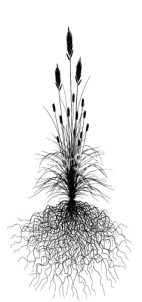Plants have nutritional requirements that must be met for them to grow properly – just as people do. So far, a minimum of sixteen elements have been found to be essential for plant growth. These required elements are carbon, hydrogen, oxygen, nitrogen, phosphorus, potassium, sulfur, calcium, magnesium, boron, chlorine, copper, zinc, iron, molybdenum and manganese. Several other elements including cobalt, vanadium, silicon, and sodium appear to be necessary for some plants but have not been proven to be required by all. Research continues on the role these elements play in plant systems.
Plants take in carbon, hydrogen, and oxygen from the air and water. Together with nitrogen, sulfur, and phosphorus, these elements form the plant’s living tissue or protoplasm. Macronutrients are those needed by plants in large quantities. They include nitrogen, phosphorus, potassium, calcium, magnesium, and sulfur. The rest of the mineral elements are needed in very small quantities and are often referred to as micronutrients.
Nitrogen, phosphorus, and potassium are the three nutrients present in most fertilizers because the quantities in soils often fall short of plant needs. Nitrogen is associated with green leafy growth. It is found in proteins so nitrogen is in every single plant cell. Leaves tend to grow larger as nitrogen levels increase. Too much nitrogen causes the cell walls to become thinner and the new foliage to become more succulent and often, more attractive to insect and disease organisms.

Nitrogen is also present in chlorophyll molecules. Anyone who has taken biology knows that chlorophyll is essential for photosynthesis to occur. Plants deficient in nitrogen will commonly exhibit light green or yellow colored leaves.
Phosphorus is essential for proper fruiting, flowering, seed formation, and root branching. Large amounts of this nutrient are found in actively growing root cells, fruits, and seeds. Phosphorus plays a key role in plant energy storage and transfer. Energy obtained from photosynthesis is stored in phosphorus compounds for use during growth.
Phosphorus is important for plant maturity. Too much phosphorus may cause plants to produce fruits or flowers before they have had enough time to produce supportive vegetative growth. Deficiency symptoms are not always easy to spot, but a general reduction in growth often occurs. Sometimes leaves may show a reddish-purple color and plants may be late to produce fruits and flowers.
Potassium is necessary for protein synthesis and the formation and transport of sugars and starches in the plant. Potassium is also needed for the action of certain enzymes and adequate potassium nutrition helps increase resistance to cold, drought, and disease in many plants.
Disease susceptibility may be, at least in part, related to the types of compounds a plant produces. Plants growing in soils deficient in potassium tend to have higher levels of soluble sugars and amino acids, both of which encourage the activity of plant pathogens. Plants deficient in potassium may also have small of misshapen fruit, and yellowing or scorching along the edges of lower leaves.
Calcium helps build cell walls and is vital to plant tissue formation. Weak stems often mean not enough calcium is present in plant tissues. Another symptom of a calcium deficiency is the failure of root tips or terminal buds to develop. This may be expressed as blossom end rot in tomatoes, bitter pit in apples or scorched leaf borders in cole crops.
Magnesium is involved in a large number of physiological and biochemical functions. It is an essential component of the chlorophyll molecule so plants having a deficiency will often show signs of interveinal chlorosis. This means the area between the veins of a leaf turns yellow while the veins remain green. Seeds, especially those rich in oil, like sunflower will accumulate magnesium so often deficiencies show up late in the season when the demand for the nutrient is high.
Sulfur plays an important role in protein synthesis and in the functioning of several enzyme systems. It is responsible for the taste and smell of plants in the onion and mustard families. Sulfur is usually not deficient in New England soils as it is deposited as an industrial pollutant. As industrial emissions become cleaner, there is a concern that this area may experience sulfur deficiencies in certain crops. Presently sulfur is applied to soils in order to lower the pH when growing acid-loving plants such as blueberries and azaleas.
Chlorine and sodium are electrolytes, which act to regulate the plant’s internal water pressure. The role of vanadium is somewhat speculative but is known to benefit the growth of higher plants. Silicon is a structural component of the plant’s cell walls.
The other minerals are all involved with plant enzyme systems. They are needed in very tiny quantities and are generally found in sufficient amounts if soil pH and organic matter levels are favorable.
Cultivated plants, like vegetables and lawn grasses, rely on humans to provide many of the nutrients they need to grow and develop. Good cultural practices, fertilizing and regular soil testing are two ways to help ensure garden and landscape plants receive the essential nutrient elements they require.
By Dawn Pettinelli, Associate Extension Educator, PSLA. 2015.
Questions? Contact:
UConn Soil Nutrient Analysis Laboratory
Department of Plant Science and Landscape Architecture
Phone: 860.486.4274
Email: soiltest@uconn.edu
Website: soiltesting.cahnr.uconn.edu
UConn is an equal opportunity program provider and employer.
©UConn Extension. All rights reserved.